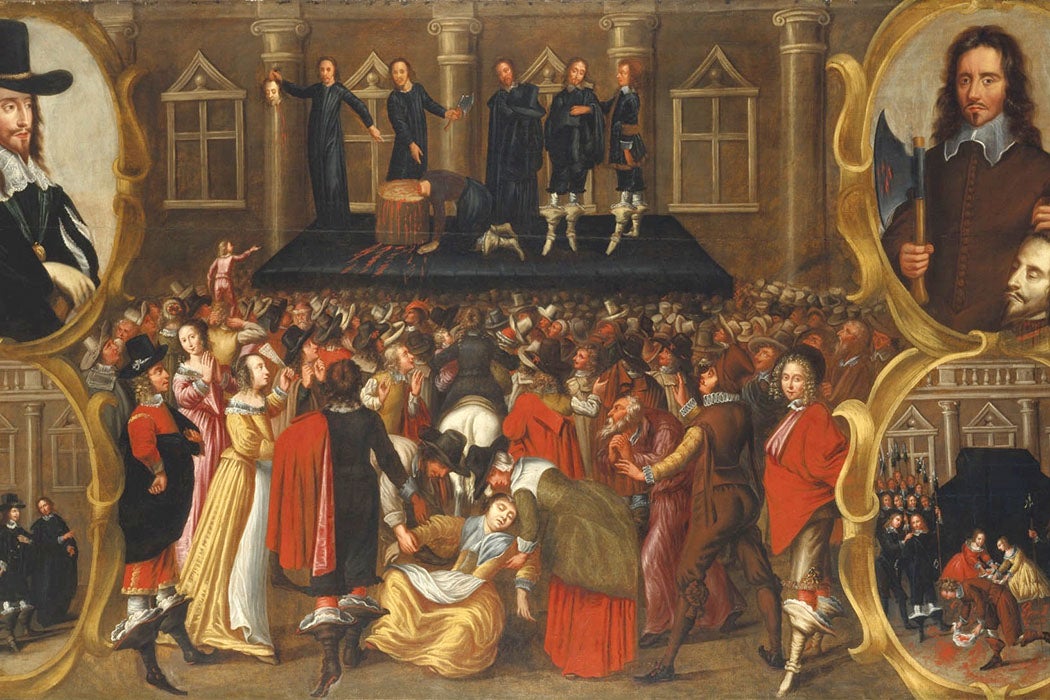Seventy-three-year-old Charles Windsor enters history as the oldest British monarch to be coronated. As King Charles III, he must inevitably remind people of his same-named predecessors. The first two Charleses-in-Charge reigned during the seventeenth century’s radical restructuring of the idea of monarchy. As a result, the third Charles inherits a very different crown.
Charles I, coronated in 1626, still had plenty of the old kingly sacredness about him in the eyes of many of his subjects. His son, Charles II, coronated in 1661, much less so. Charles II’s younger brother, James, coronated in 1685, none at all. Since the last Stuart King, British monarchs have been less than sacred.
Like his predecessors, Charles I was “the Lord’s anointed.” His very body was supposed to be magical: he could, it was claimed, cure with his hands. This made him a blessed martyr after his execution, although not to the Parliamentarians who had him killed. His execution was a fateful day for monarchy, for he turned out, after all, to be nothing but a man. As historian Robert Zaller writes, the 1649 trial and execution of Charles I “was by any measure the most scandalous political event of the seventeenth century. It made the great English rebellion a true revolution, and gave the notion of popular sovereignty its baptism in blood.”
Zaller details the end of the ancient tradition of the sacralization of the king’s body. Pagans like the Egyptians and the Romans could make their rulers gods. Christians made their rulers agents of Providence, God’s anointed. The anointing was quite literal: consecration came from chrism (holy oil) poured over the head. Consecration was even more important than crowning.
“Kings whose claims were disputed were accordingly anxious to to be consecrated as quickly as possible,” writes Zaller. “Both Edward IV and Richard III rushed to be crowned, and the Yorkist kings claimed to have been anointed with chrism conveyed directly to Thomas á Becket by the Virgin.”
In addition to blessed sovereignty, consecration also supposedly imbued monarchs with the ability to heal by touch. Hence, the name “King’s Evil” for the disease scrofula (mycobacterial cervical lymphadenitis), which both English and French kings were supposed to be able to cure by the laying on of royal hands.
All this very much “clashed with Reformation ideals” about idolatry and thaumaturgy (miracle-working). Yet the notion of the consecrated king remained significant even after Henry VIII’s break with the Catholic Church. Legitimacy of absolute rule had to be grounded in something, after all.
This notion of the sacred king was, however, severed first by Charles I’s trial—which Zaller calls “an act of civil resistance and of collective desanctification”—and then with the emphatic swing of the executioner’s blade.
The tumultuous eleven years between the reigns of Charles I and Charles II, the Interregnum, broke the long tradition uniting royal heredity, Christianity, and sovereignty. So, while the Restoration of Charles II certainly started off with much pomp, all of the king’s men and all the king’s horses couldn’t put the king’s sacred body back together again. Charles II touched for scrofula in a big way, but royalist attempts to promoted him into sacredness didn’t take.
Weekly Newsletter
Charles II himself was the problem. Zaller writes, “Charles’s philandering and bastardizing, and the sordid atmosphere of his court, proved devastatingly subversive of attempts to refurbish the image of sacred monarchy.”
The satire, derision, and outright mockery that resulted from the scandals and hypocrisies of the court may have been sharper than an executioner’s blade. No amount of holy oil was going to clean up Charles II, with his circa fourteen illegitimate children. With no legitimate heir, the crown passed to his younger brother, James. And King James II ruled for less than four years before he was ousted by Parliament in 1688—no more would kings be imbued with divine powers.







